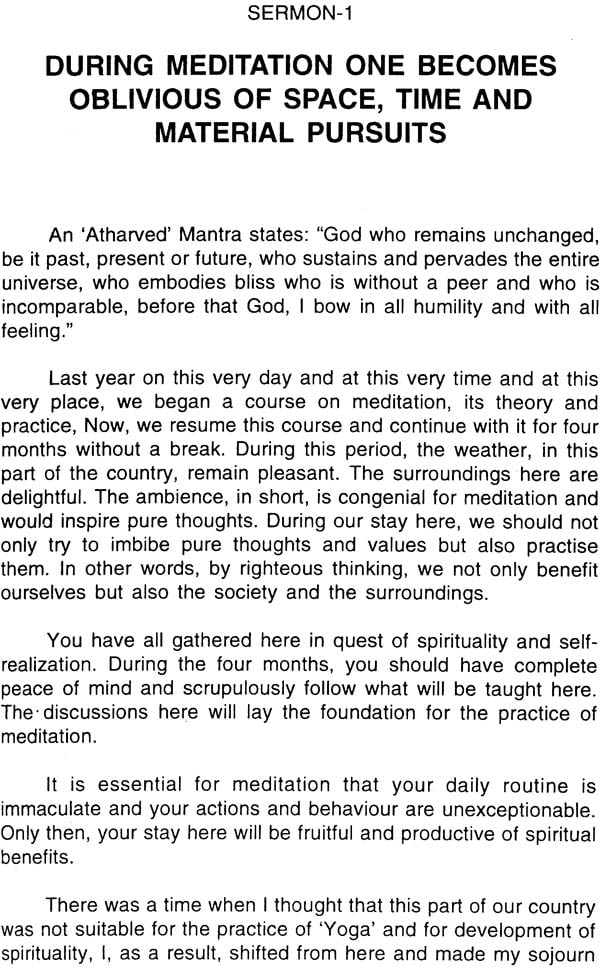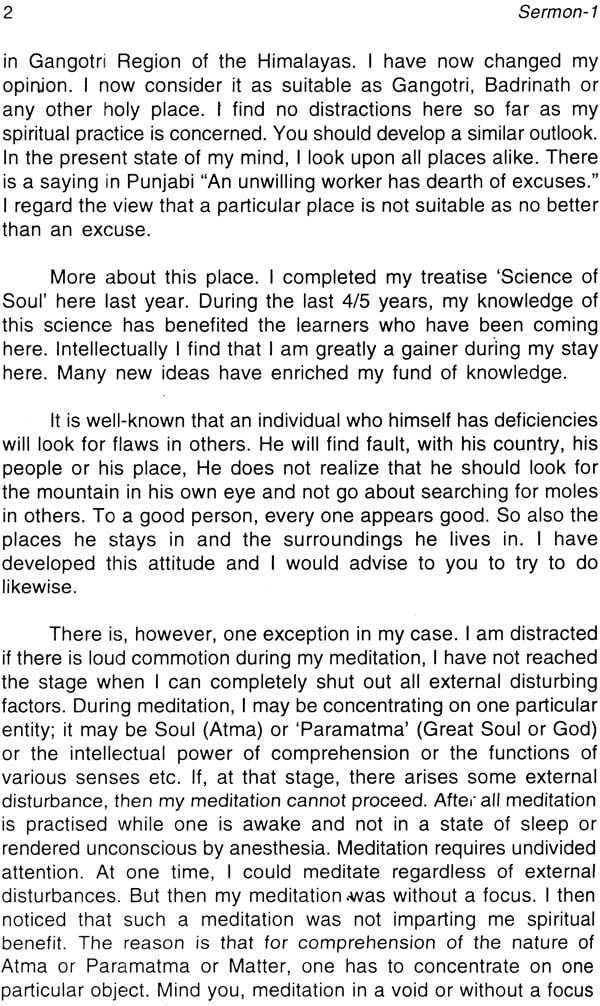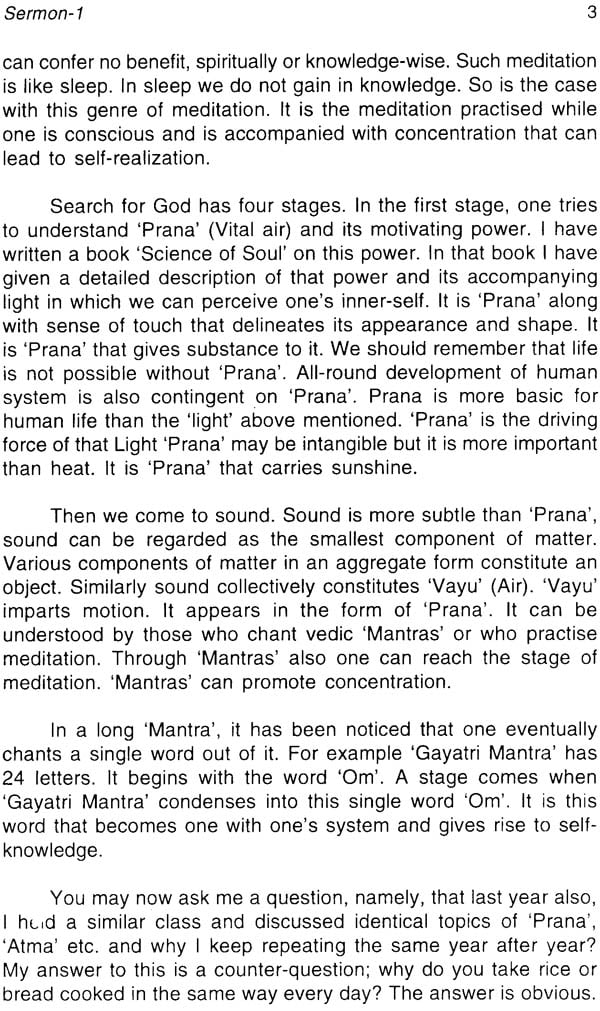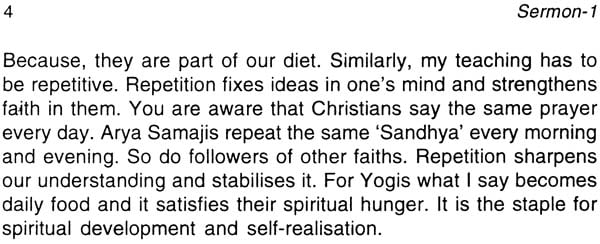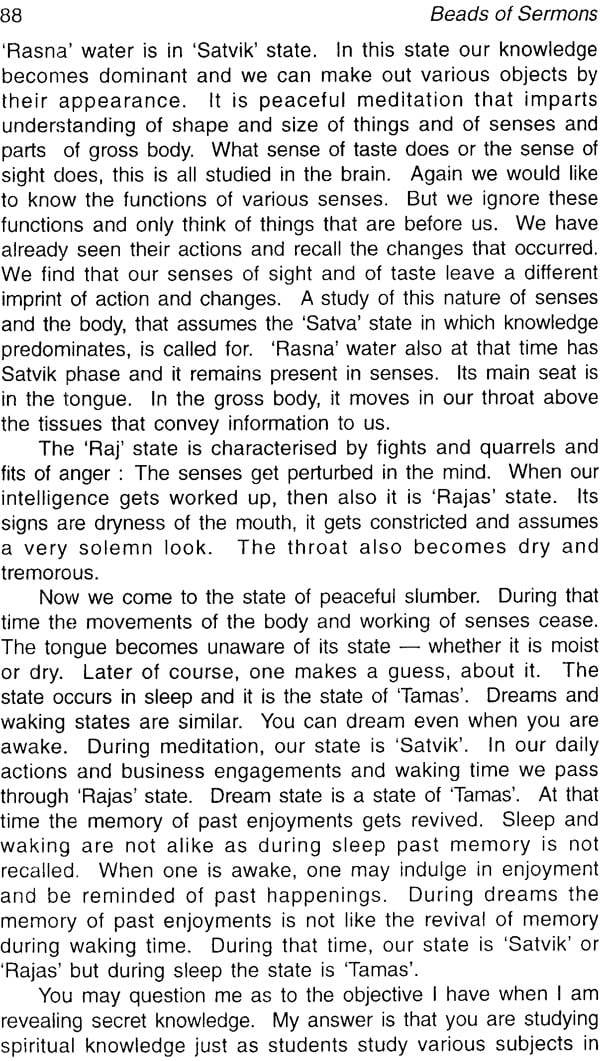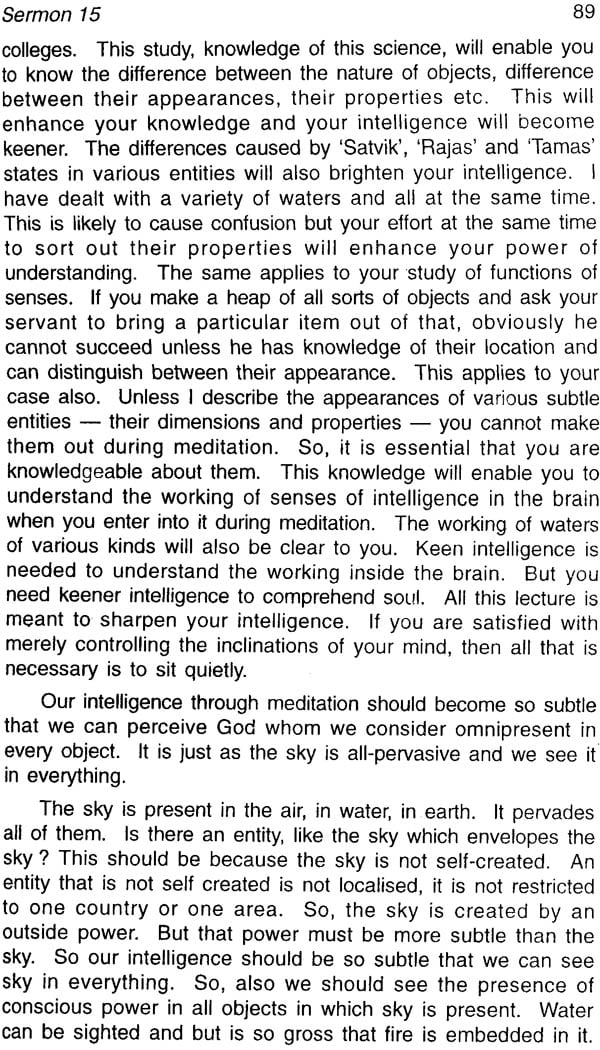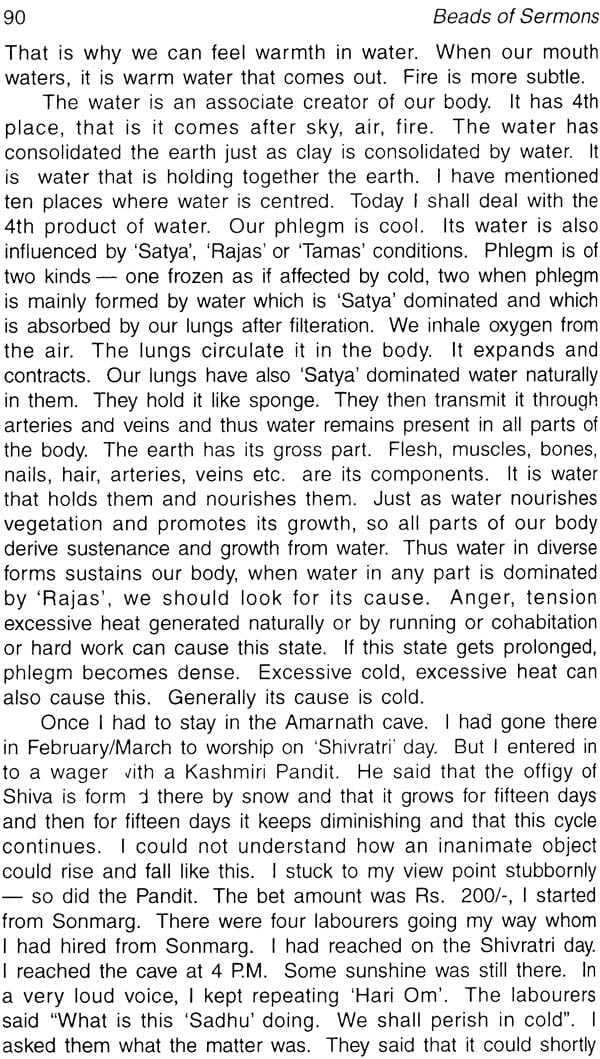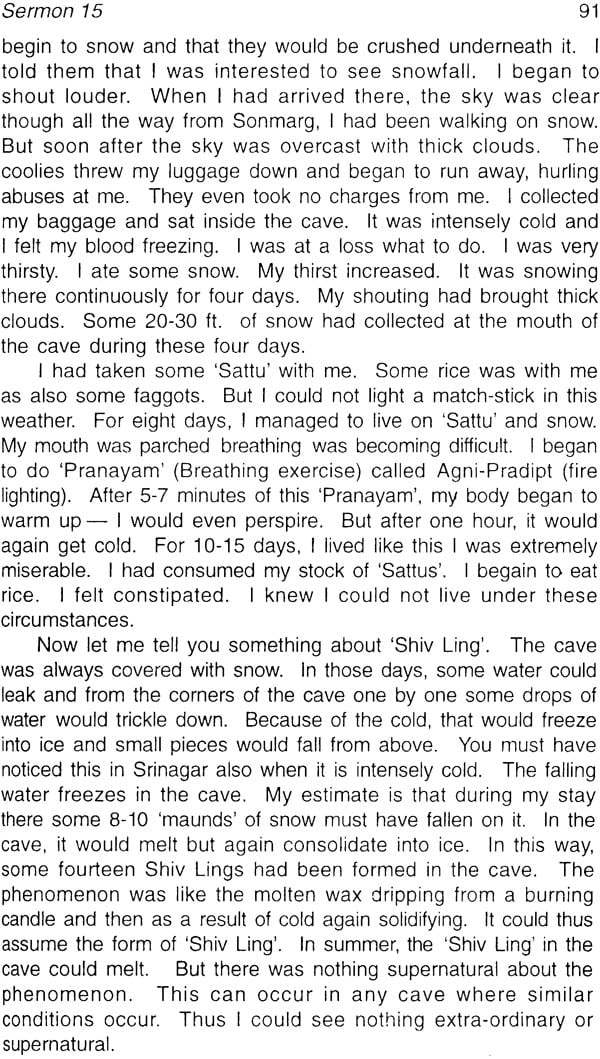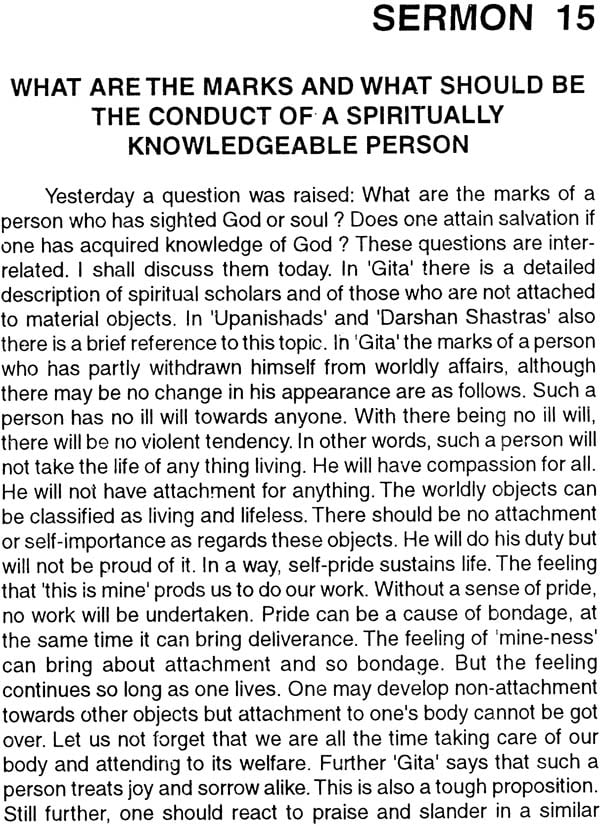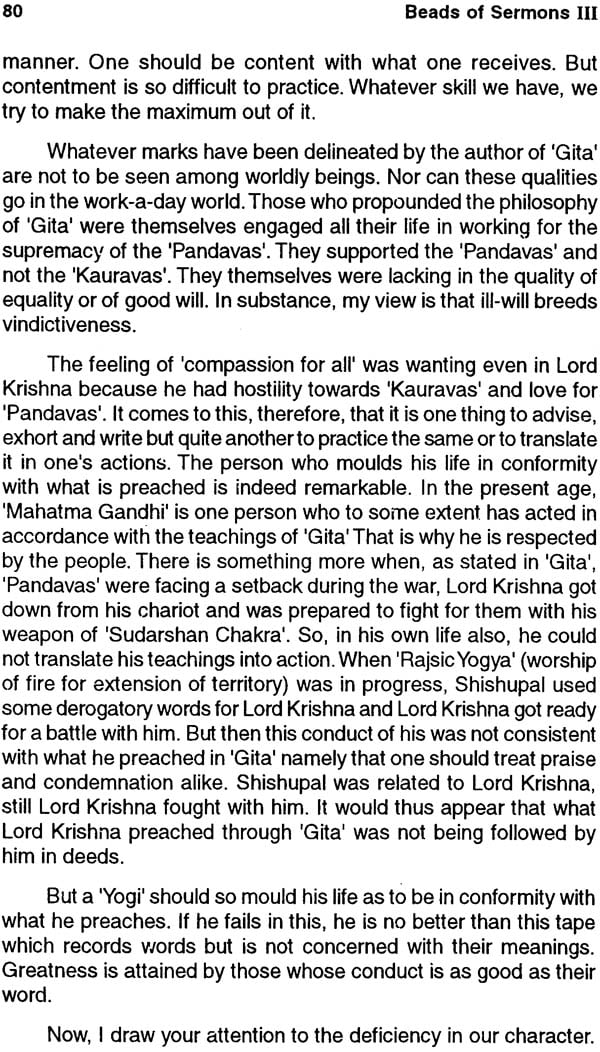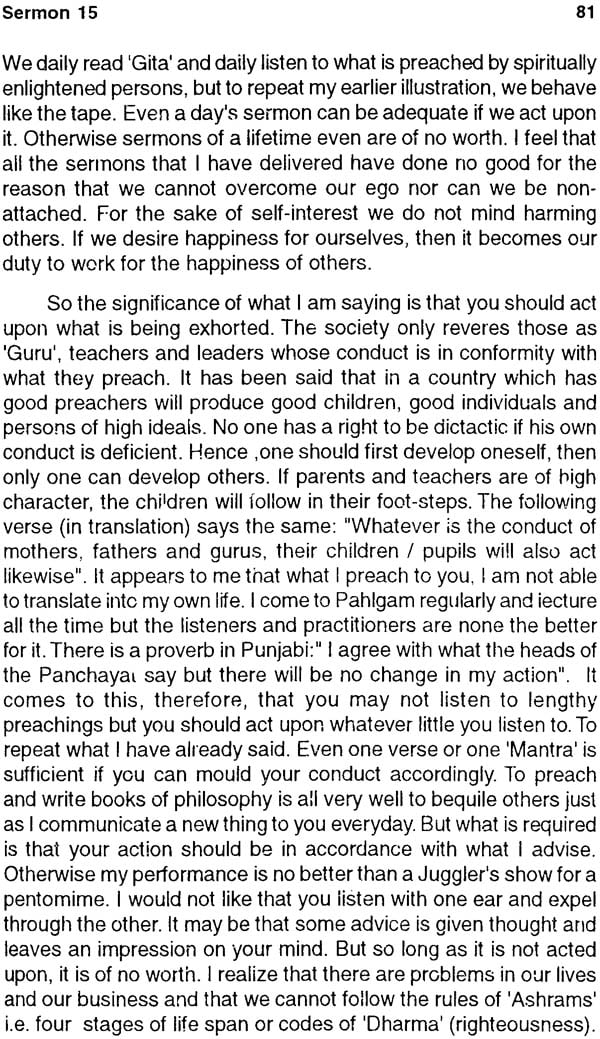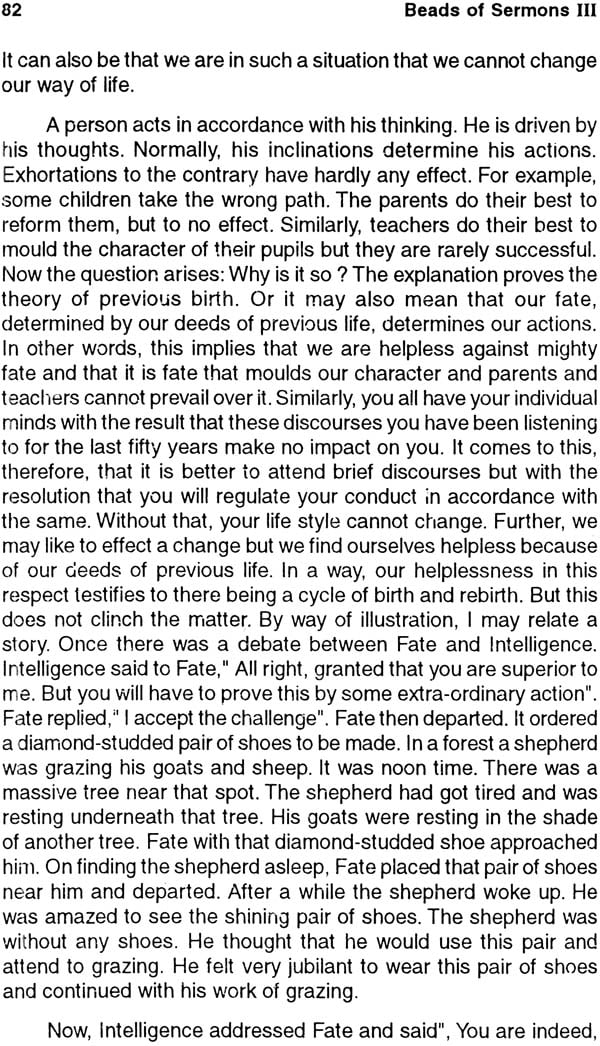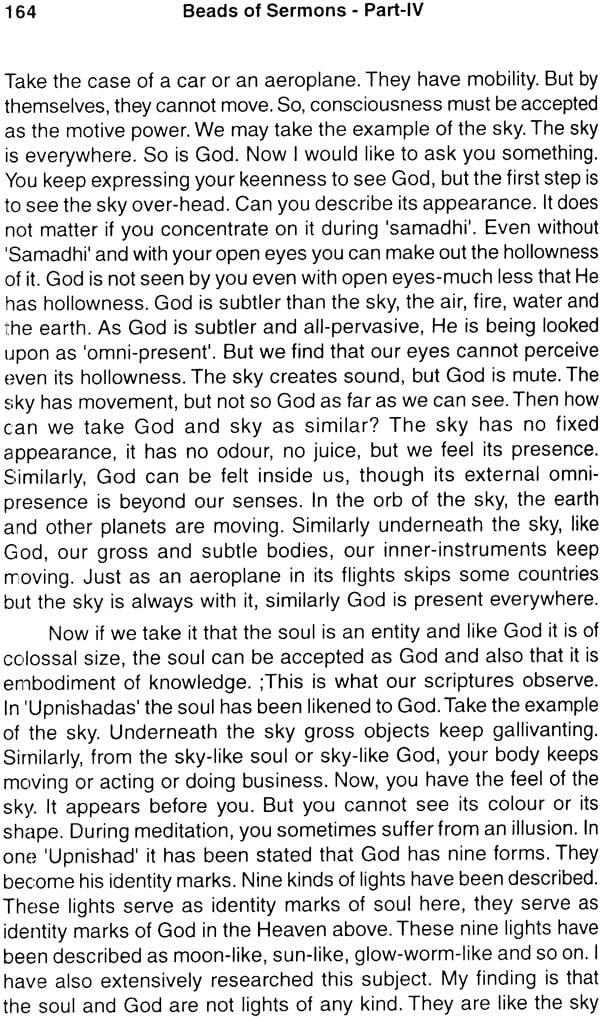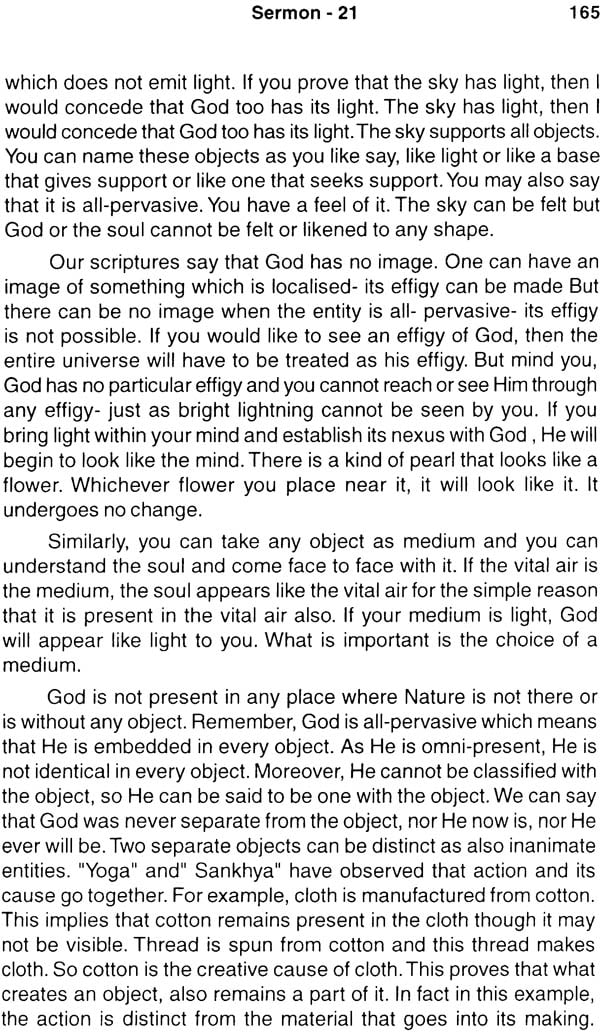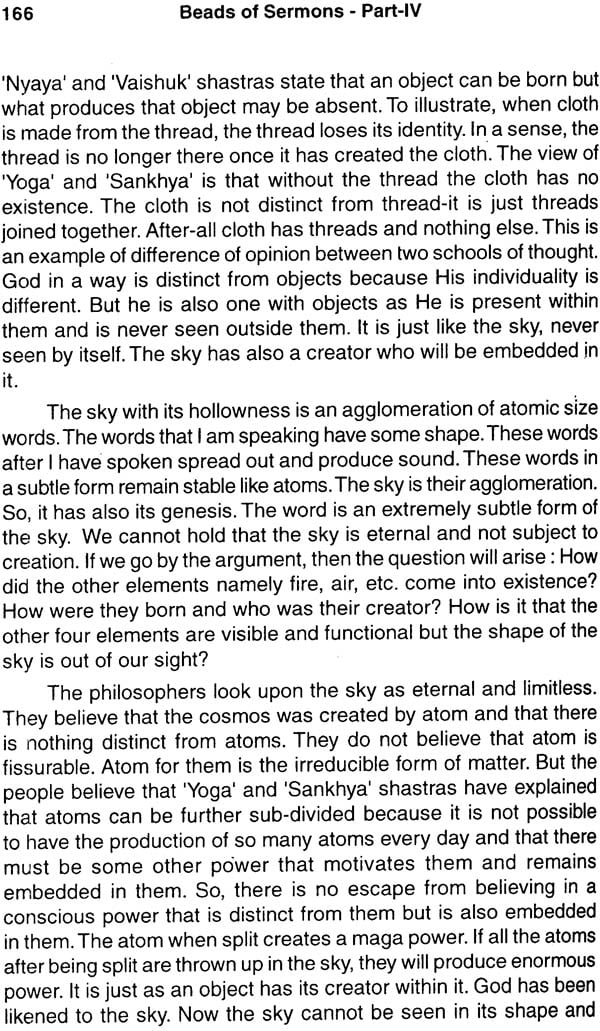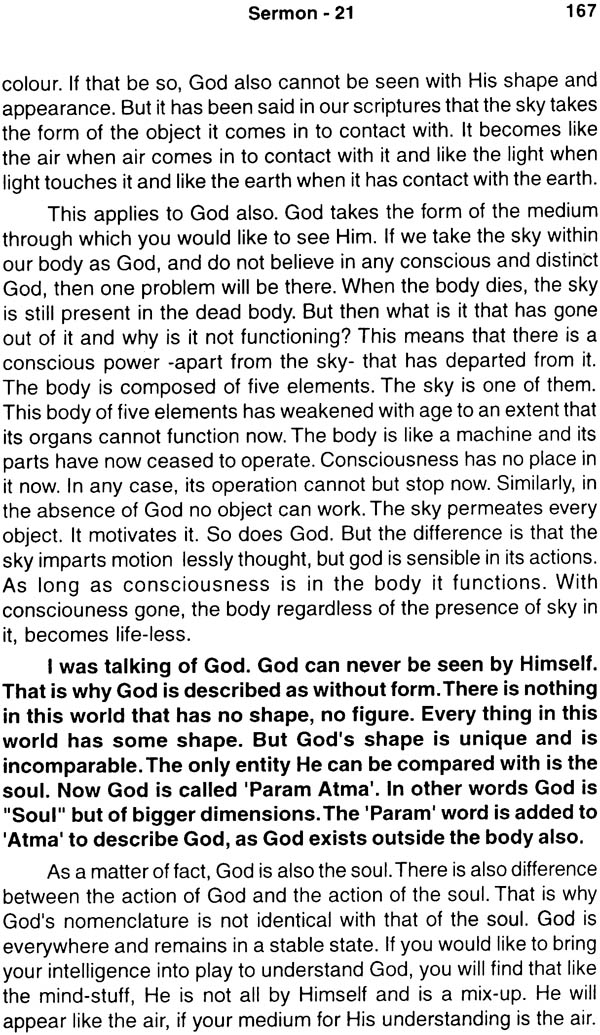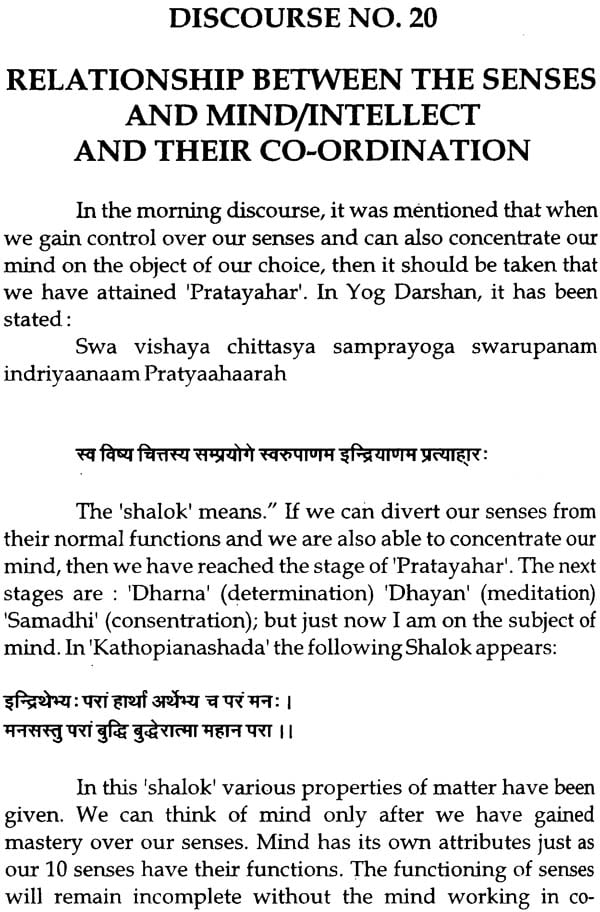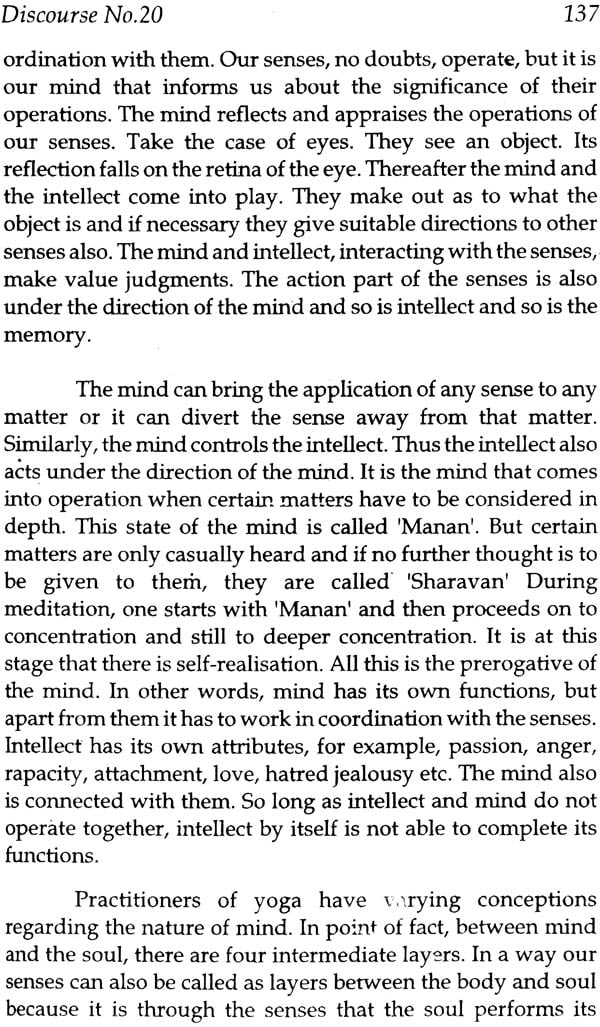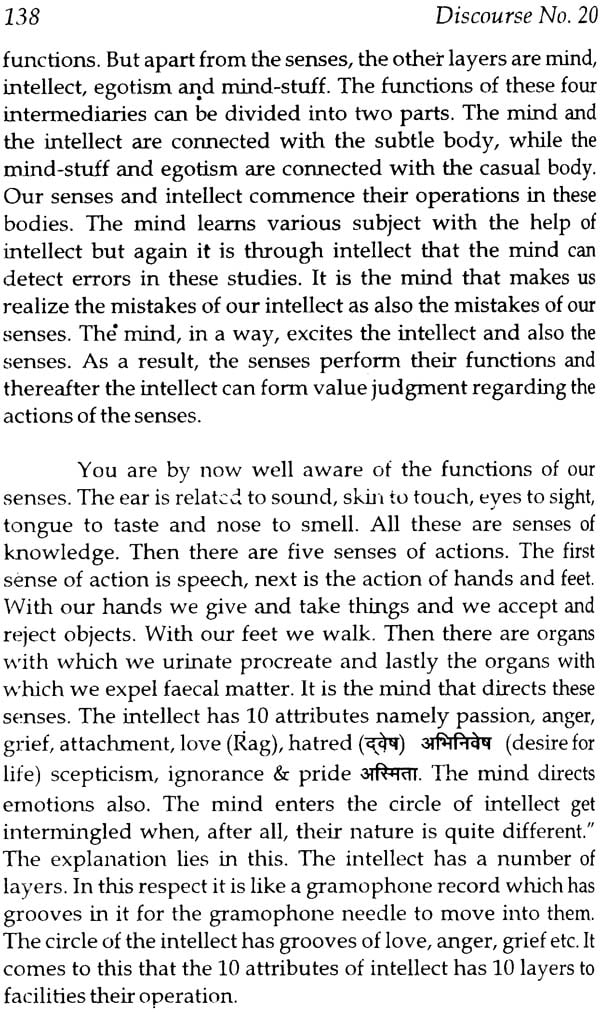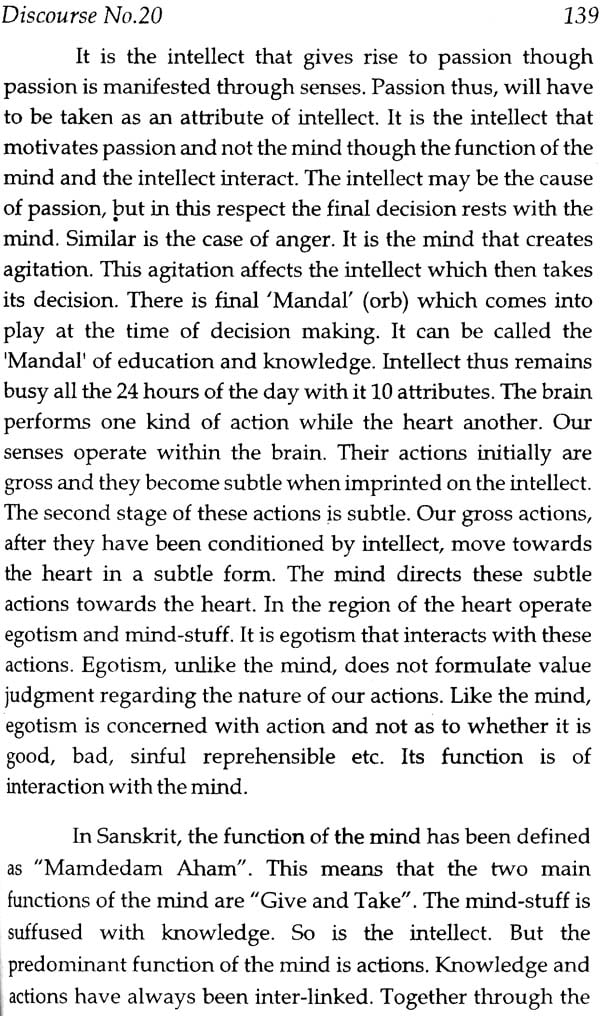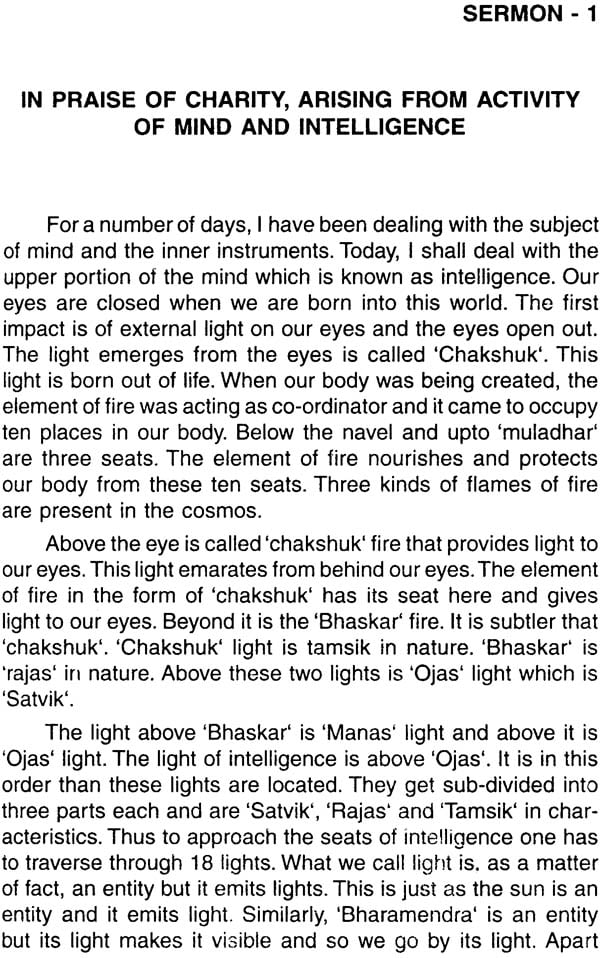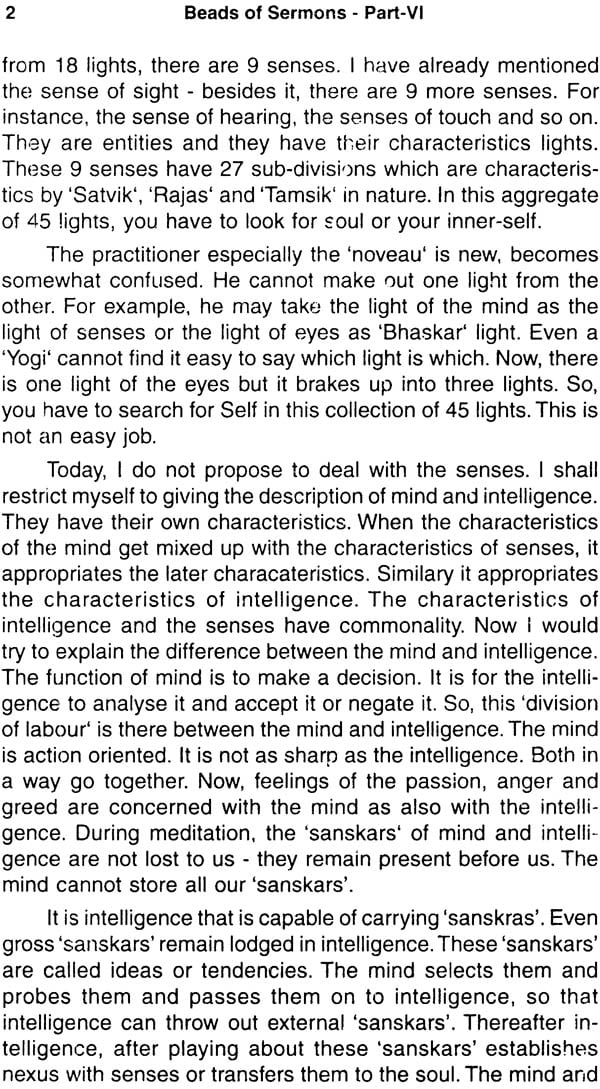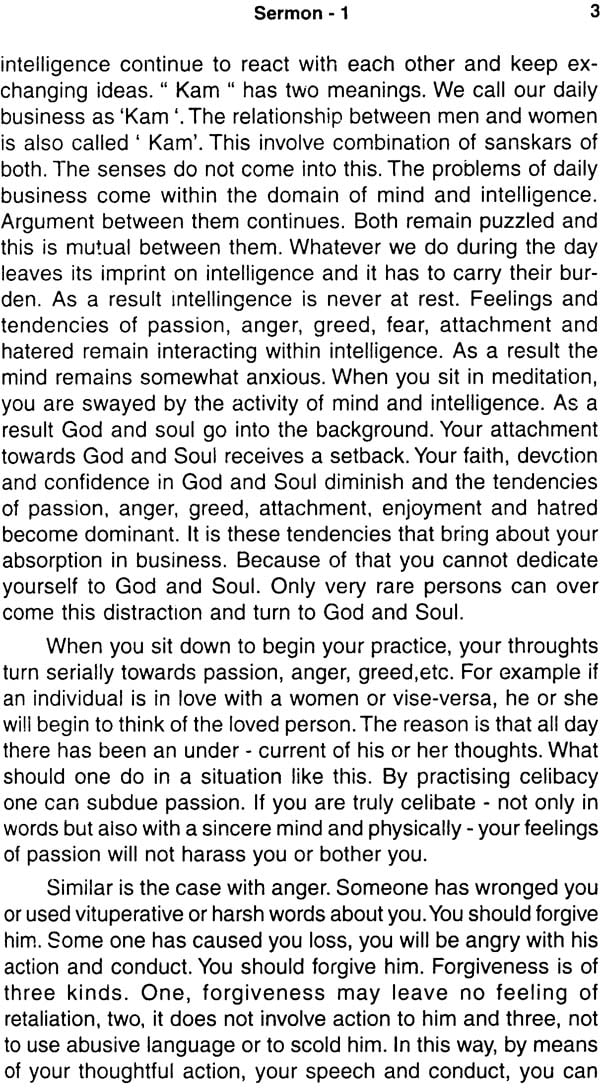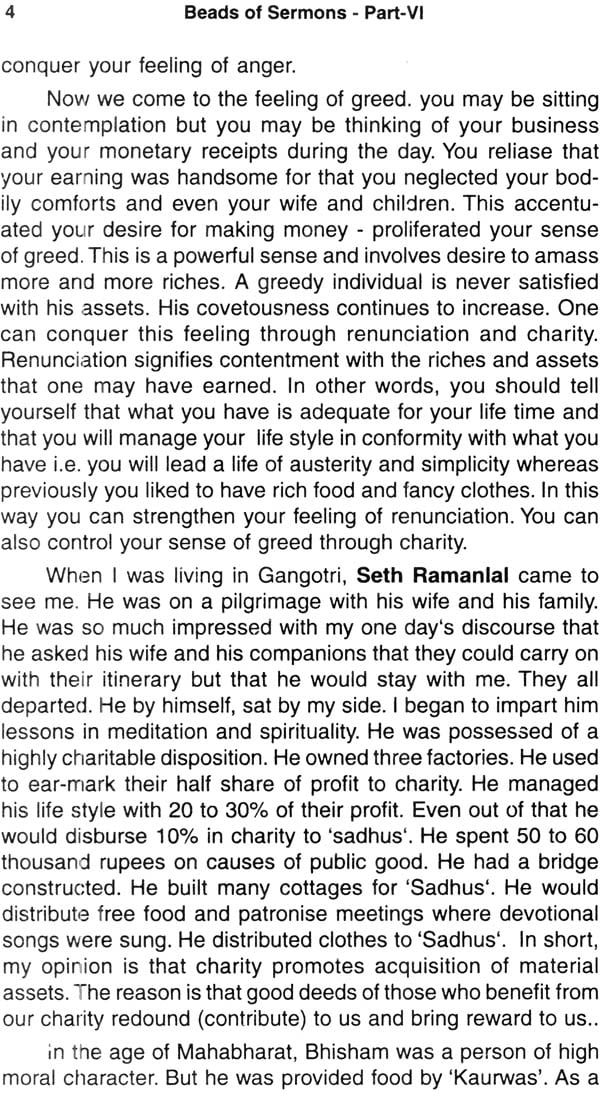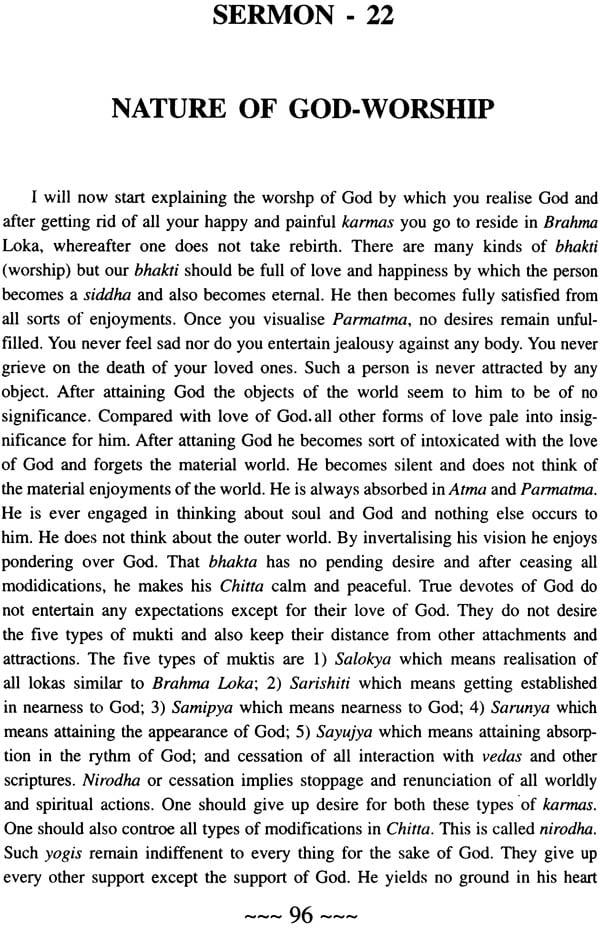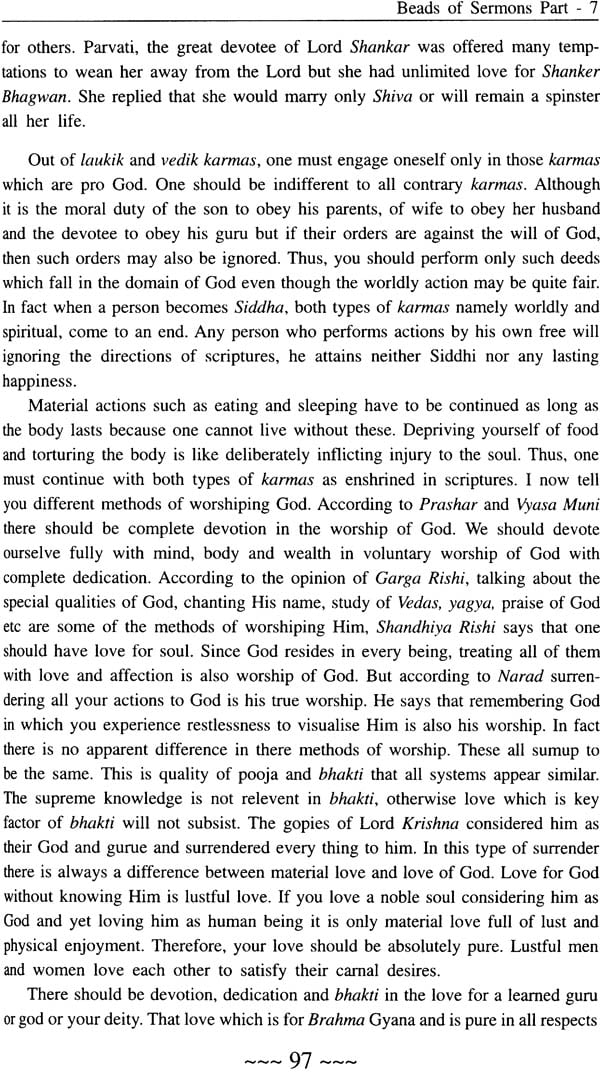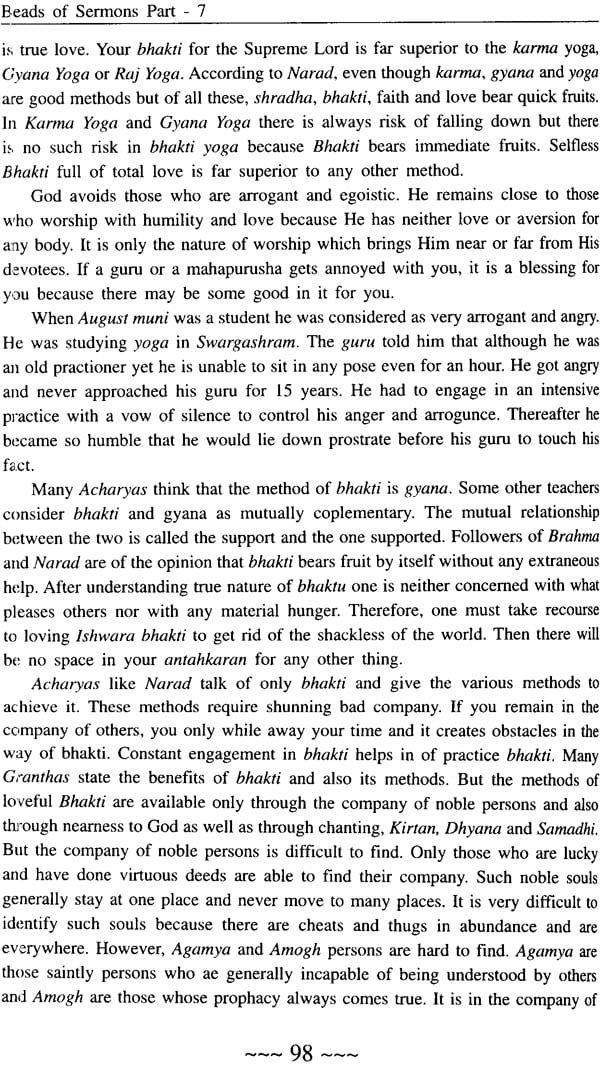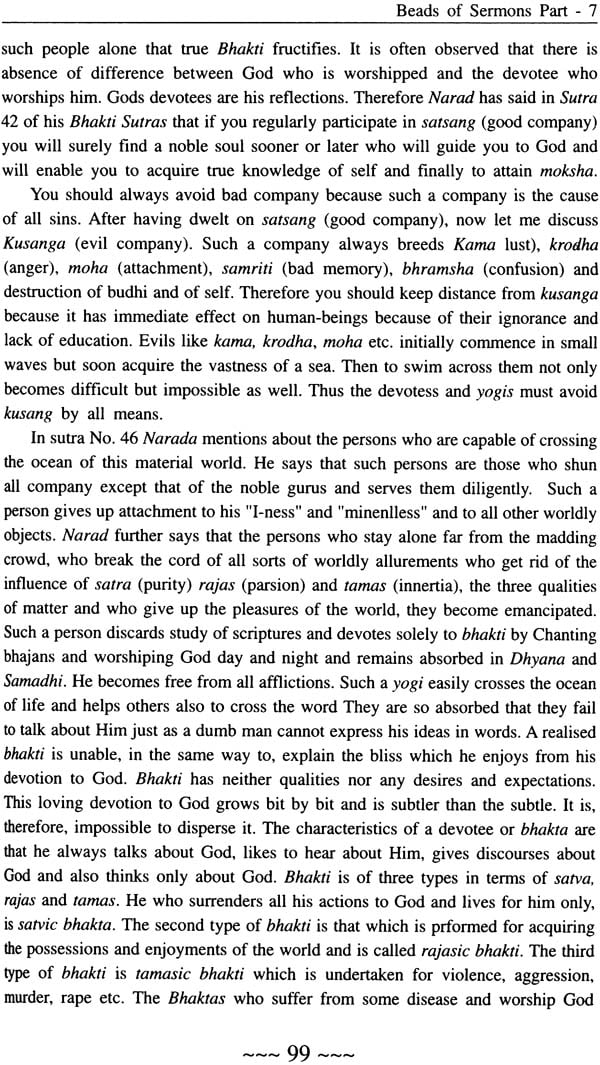
Beads of Sermons (Set of 7 Books)
Book Specification
| Item Code: | NAG591 |
| Author: | Yogeshwaranand Paramahansa |
| Publisher: | YOGA NIKETAN TRUST DELHI |
| Language: | English |
| Edition: | 1995 |
| Pages: | 1098 |
| Cover: | Paperback |
| Other Details | 8.5 inch X 5.5 inch |
| Weight | 1.20 kg |
Book Description
About the Book
This book is an English rendering of Yogiraj Shri Yogeshwaranand 27 discourses, delivered on various occasions, on Yoga in its historical perspective and on human life and its complexities. They embody the wisdom that our sages of yoga preached and Maharaj ji has explained it in simple and easily understood language.
What Maharaj ji has expounded in these discourses are eternal truths which are as much relevant today as they were in ancient times. The great merit of these discourses is that they contain advice which can be easily put into practice by people without any change or break in their work-a-day life.
This book should prove an invaluable guide for all those who are spiritually inclined and aspire to give meaning and content to their life and strive to invest it with peace and happiness.
About the Author
Yogiraj Brahmarshi Shri Yogeshwaranand Paramahans, formerly known as Brahmachari Vyas Dev ji, left his home at a tender age of fourteen in search of knowledge and self-realisation. The young Brahmachari spent the early years of his life in the study of Sanskrit and mastering the scriptural lore. He then, followed the path of ancient rishis of the Himalayas and practised the most difficult tapasya and yogic sadhana while continuing the search of real guru who could lead him to the final goal. He came across a number of ascetics about whom one reads only in the scriptures but his search came to an end only when he met Avadhoot Swami Atmanand ji, who had then returned from Tibet.
By constant and dedicated practice of meditation he experienced various types of Samadhis, some of them lasting for several weeks which culminated in his gaining knowledge of self-realisation, origin and dissolution of cosmos and the goal of human existence. The esoteric knowledge which used to pass from guru to disciple through personal relationship and which sometimes required not only a whole lifetime but several lives, has now been set down, at the behest of his guru, in his books.
Volume VII
Preface
In this seventh part of the lecture series, his holiness Shri Gurdev Swami Yogeshwarananda Saraswati, has put forth 27 lectures from his lotus like mouth which has been divided into two parts for the convenience of the Sadhakas aspirants and for saving the treatise from becoming too extensive. Here those subjects have been given more importance that are predominantly related to the life of a house holder (grhasta). The stage of a house-holder viz the grhastashrama is not restricted to being a place for merely experiencing worldly joys and sorrows but shouldbecome the temple for acquiring philosophical learning, wherein the aspirant experiences the truths of life and considers those to help promote his sadhana(aspiration) and not to obstruct it. The problems of life give people the strength for the sadhana, generate detachment and handling and facinf the difficulties inspire him to perform sadhana. Therefore the aspirants who are house-holders(grhasta) should not consider themselves unworthy for yoga or tatvagyan(knowledge of the ultimate principle). If they carry on their life thinking themselves to be pursuers of the path of spirituality, then this knowledge is for them also.
We hope this treatise will guide the wise aspirant on the right path like a beacon; this alone is our intent.
Introduction
In this seventh part of the lecture-series, there are 27 lectures on various subjects, filled with great essence and profound scholarship. Man is afflicted with faults and therefore there is no progress in his sadhana. What are these faults. What are the means of removing them? This has been discribed in the first sermon. Disease makes the body old and weak but the body of the aspirant should be endowed with excellent health as a means of accomplishing the four sumrnom bonnums of life(purusharthas) is described in the secound sermonllecture. What is the position of atma (soul) and paramatma(supreme being) are situated in the body and cosmos is discussed in the third and fourth sermons. People have several illusions and misconceptions regarding birth. Where does the soul go after death; how does birth occur; what are the effects of samskaras, how is man affected by samskaras and what goes out from the body at the time of death? All this has been described from the fifth to the tenth sermons.
What are the means neccessary to set the mind at peace, which are those obstacles which snatch away the peace of mind and make the mind fickle, what is the solution to remove those obstacle, what is the use of action (karma) in life, can man contemplate liberation despite bound by actions? All this can be seen in the accomplishment of Karmayoga. In samadhi yoga one can know about the transformation of mind and body due to knowledge(guas) (dhyana) and supper consciousness (samadhi); what the aspirant becomes due to this and how should the sadhana of the aspirant be like. Man is replete with love and devotion. He needs the grace of the lord for staying away from faults and forwarding off obstacles. How should one worship him(the lord) what is devotion, what is love, what is truth, how should these be incorporated in one's life, can be read in the sermons on devotion of God and the nature of devotion. The magnitude of change that worshipping God and the Brahman brings in ones life is described in the Prayer to the Lord.
The focus of all these sermons is on making life perfect. Without perfection in life there can never be progress in one's sadhana. Limitations and faults make man hollow. Sadhana is the only thing that fills up this hollow and makes man feel complete. It is then that man experiences the proximity with God. It is the very aim if sadhana to make life complete, removing emptiness and filling it with the grace of lord and Godliness. This only is libration from the bondage of life and this can be accomplished by man even while following his duties as a house-holder.
Contents Volume I
| 1 | During Meditation One Becomes Oblivious of Space, Time and Material Pursuits | 1 |
| 2 | Understanding Soul Through Good Deeds, Right Knowledge and Meditation | 5 |
| 3 | Do Actions Bring Forth Their Own Results or is it God that Wills the Results? | 9 |
| 4 | Mastery Over Knowledge of Brahma (Creator) | 12 |
| 5 | Can Omni-present Consciousness be Envisioned | |
| in the Skull or in the Heart | 17 | |
| 6 | Vision of God by Means of Knowledge, Deeds and Worship, Operating Through 'Pranas' (Vital Air) | 21 |
| 7 | Self-Realisation Through "Prana" in all the three Human Bodies | 24 |
| 8 | The Shortest Path to God - Peace of Mind and Bliss | 28 |
| 9 | Step by Step Knowledge of Objects and Soul - that is Knowledge of Nature and Human Kind | 30 |
| 10 | Role of Impressions of the Mind of Previous Births (Sanskars) in Bringing About Cycle of Births & Re-Births and their Complete Account as Given by Gradual Stages in Our Scriptures | 33 |
| 11 | Envisioning Soul with the Help of Inner Lights | 38 |
| 12 | Eight-fold Abnormalities that Afflict Sincere as Given by Gradual Stages in Our Scriptures | 41 |
| Devotees, Worshippers and Yogis | 41 | |
| 13 | To Envision Soul by Means of Divine Lights | 44 |
| 14 | Principal Ways to Acquire Super-Power and Bliss - Are Deeds Rewarded or Penalised on Re-Birth or in this Very Life | 47 |
| 15 | Enunciation of Universal 'Dharma' | 52 |
| 16 | Can 'Dharma' 'Arth' 'Kam' and 'Moksh' or 'Dharma''Arth' 'Gyan' and 'Moksh' Prevent Extreme Suffering | 57 |
| 17 | Prevention of Extreme Suffering | 63 |
| 18 | Work is a Must in Life. It is Work That Leads to Salvation | 69 |
| 19 | God Created This World, But After Creation, He Entrusted it to Human Beings. So Enjoy This World But Within the Framework of Spiritual | |
| Knowledge and with an Attitude of | ||
| Non-Attachment | 72 | |
| 20 | Is Their in Reality any Realm of Salvation | 77 |
| 21 | Attainment of Salvation | 82 |
| 22 | Attainment of Salvation (Continued) | 88 |
| 23 | Movement Within the Realm of Salvation - | |
| Four Stages or Four Abodes of Salvation | 92 | |
| 24 | Out of 4 Ways of Attaining Salvation - Principal | |
| are Gyan & Non-Attachment (Vairag) | 97 | |
| 25 | Science of Human Body and Inner Instruments | 100 |
| 26 | Is the Size of Soul Atomic or Larger or Equal | |
| to the Size of the Body | 105 | |
| 27 | Knowledge Mainly has Two Centres - | |
| Forehead & Heart | 109 |
| Search for Soul and God through the medium | ||
| of Light and Vital Airs ... Breathing in & out | 1 | |
| 2 | Inter-action between the subtle divine lights of | |
| Brahmrandhra (a point, like a hole, in the head) | ||
| and subtle body. | 7 | |
| 3 | Knowledge of Self through interaction of | |
| Knowledge, Intelligence and Imagination with | ||
| manifest or unmanifest Knowledge of | ||
| 'Brahmrandhra' and Heart. | 11 | |
| 4 | Visualising Soul and Divine Knowledge through | |
| Various Means. | 23 | |
| 5 | Enjoyment and Mind-impressions - their | |
| Relationship and Means of Attaining Salvation. | 27 | |
| 6 | Six Components of Eight - Pronged Yoga. | 32 |
| 7 | Control over mind and senses | 42 |
| 8 | To Acquire knowledge of Soul and God | |
| through the medium of the element of Water | ||
| in the Body. | 47 | |
| 9 | Visualising body, Soul and God through the | |
| medium of Ten-Pronged Water element. | 51 | |
| 10 | Worship of water element and envisioning of | |
| Inner-self thereby. | 56 | |
| 11 | There is a Ved Mantra which translates the Mind. | 60 |
| 12 | For a number of days we have been discussing the | |
| question of worship of God through the medium of | ||
| water. Our conclusion has been just as air and fire | ||
| can be the medium of worship of God, so can be | ||
| the water. | 65 | |
| 13 | May all be happy! May all be free from Want! May all | |
| be good! May none have any sorrow! | 70 | |
| 14 | Bondage and Salvation are natural. All proclivities cannot be | |
| eliminated or destroyed. All 'sanskars' after they arise, get | ||
| dispersed, attenuated but remain dormant and ultimately | ||
| aggregate at the time of Doom and at the time of creation | ||
| they secure liberation. | 79 | |
| 15 | Worship and knowledge of God through the medium | |
| of 'Prabha' (Radiant) Water. | 83 | |
| 16 | To worship and to visualise soul and God in the body | |
| with the help of special properties of water and earth, | ||
| namely oiliness and perspiration and their genesis. | 95 | |
| 17 | Experience in One's life of the pleasure of Heaven and | |
| pains of Hell. The path of this life is paved by our deeds in | ||
| youth, our efforts to amass wealth, our struggle to achieve | ||
| power and finally the extent of our ignorance. | 105 | |
| 18 | To attract subtle elements of smell and sound from a | |
| distance during meditation. | 110 | |
| 19 | Pleasure and Pain are inborn. No one can be immune from | |
| them. Through meditation we can confine them. Visualising | ||
| soul through four kinds of meditational poses. | 114 | |
| 20 | Virgin Lalita Devi's vision of Soul through Samadhi with | |
| and without super-consciousness of thoughts and objects | 118 | |
| 21 | To visualise Soul, through control on desires. | 122 |
| 22 | Control of mind-impressions through knowledge and | |
| attainment of eternal salvation. | 127 | |
| 23 | To visualise God and Soul through Knowtedge and Action. | 131 |
| 24 | Inactivity in God. | 135 |
| 25 | By means of self-realisation and vlsualisinq God through | |
| 'Samadhi', we can have access to salvation. | 142 | |
| 26 | To visualise Soul and God by moving from gross objects | |
| to subtle objects and with the support of past and present | ||
| self. | 146 | |
| 27 | 151 |
| 1 | To observe four "Dharmas" (Righteous ways) | |
| is a Tough task | 1 | |
| 2 | Good Conduct is the Primary Virtue | 6 |
| 3 | To Envision Soul through 'Unmani', 'Shambvi' | |
| and 'Shaktisanchalni' Poses | 13 | |
| 4 | Vision of Sou! & God by means of knowledge, | |
| action & worship | 21 | |
| 5 | Envisioning God through the word "Pranva" | |
| (Quality of God) | 27 | |
| 6 | To envision God with the Aid of Action, knowledge | |
| and worship and with the medium of sound and sky | 32 | |
| 7 | Attachment makes for bondage but renunciation | |
| leads ot salvation | 37 | |
| 8 | Visualising Soul and God by means of vital airs | |
| in the heart | 43 | |
| 9 | To gain spiritual knowledge, you need a preceptor | 47 |
| 10 | Envisioning Soul and God through control of | |
| inner desires. | 51 | |
| 11 | To acquire spiritual knowledge by means of | |
| meditation of various kinds | 53 | |
| 12 | How to control the mind and senses and | |
| how to self-investigate | 59 | |
| 13 | Life depends on vital air | 63 |
| 14 | Philosophic exposition of Soul & God and also of | |
| bondage and salvation | 67 | |
| 15 | What are the marks and what should be | |
| the conduct of a spiritually knowldegeable person | 79 | |
| 16 | Various methods of self-realization, prior to | |
| control of thoughts and imagination | 87 | |
| 17 | There is a Ved Mantra (Yajur Ved 40-2) in which a | |
| prayer has been addressed to God in which it has | ||
| been stated "May we live till the age of 100 years | ||
| years and die working (in harness)" | 93 | |
| 18 | Are Bondage and Salvation implanted in our | |
| Nature or are they sought for? | 98 | |
| 19 | Visualizing objects by means of light of | |
| "Brahmrandhra" | 104 | |
| 20 | Self-Realisation by means of lights of mind | |
| and intelligence | 10 | |
| 21 | To Visualize God and Soul inside the body by | |
| Means of light in "Brahmrandhra" | 113 | |
| 22 | Self-Realization in "Brahmrandhra" with the aid of | |
| Divine light of senses, mind and intelligence | 118 | |
| 23 | The element of fire also sustains life | 122 |
| 24 | A description of the heavenly world | 127 |
| 25 | Only rare among spiritually knowledgeable can | |
| follow the path of salvation | 135 | |
| 26 | How to Envision God and Soul | 140 |
| 27 | How to gain knowledge of the shape of |
| 1 | An analysis of our deeds and their results. | 1 |
| 2 | Is spiritual consciousness a merit or is it without | |
| merit? what is the real image of salvation? | 12 | |
| 3 | Relationship between material and | |
| spiritual sciences. | 29 | |
| 4 | Envisioning soul & god through worship and | |
| spiritual knowledge. | 33 | |
| 5 | To envision god through the medium of the five | |
| elements | 37 | |
| 6 | To survey important activities of the body made - | |
| up of fire, air, light. | 45 | |
| 7 | Materialistic and spiritual science. | 52 |
| 8 | How to overcome impressions of our actions | |
| through special knowledge and to overcome | ||
| obstructions in the,'way of yoga. | 58 | |
| 9 | To attain self-realization and salvation through | |
| explicit vision and proof provided by sound. | 64 | |
| 10 | Various methods for visualising mind and | |
| intelligence and to comprehend their reality. | 72 | |
| 11 | What is the nature of the power of 'kundallni'? | |
| how can it be activated? how can we visualise | ||
| the soul with the aid of kundallni? (kundallni- | ||
| power is psychic power of the serpentine-nerve). | 82 | |
| 12 | Visualising soul through vital air. | 91 |
| 13 | The primary object of human-beings is to acquire | |
| knowledge of the soul and divinity. | 96 | |
| 14 | Is soul, of mini or mega size? is it-self sustaining | |
| or dependent on something else? | 104 | |
| 15 | To acquire spiritual knowledge by means of | |
| four kinds of yoga. | 114 | |
| 16 | How hard to relinquish attachment | 121 |
| 17 | Relationship of soul and god with the universe. | 131 |
| 18 | Functions of senses and inner-instruments - | |
| their nature and control | 144 | |
| 19 | Destiny and self-effort - their relatioship - | |
| comparative precedence and power. | 150 | |
| 20 | Question- how is fate different from the | |
| impressions of good and evil deeds that | ||
| are in evidence in modern lives? | 159 | |
| 21 | The greatness of the sky and the soul- | |
| difference between the two. the sky as the | ||
| medium for perception. | 163 | |
| 22 | Comparison of god and the sky god is indivisible. | |
| sky is divisible. | 169 | |
| 23 | Introduction of indefinable divinity | 176 |
| 24 | The appearance of mind and intelligence: their | |
| functions and business | 184 | |
| 25 | in praise of celibacy (brahmacharya) | 189 |
| 26 | the dominion of cupid. how to enjoy passion | |
| with discrimination and finesse. | 196 | |
| 27 | How to control one's anger and passion. | 203 |
| 1 | Changing Prospectives of Back-Ground | 1 |
| 2 | Synthesis of Materialism and Spiritualism. | 11 |
| 3 | The Sense of Hearing, its Origin & Control. | 19 |
| 4 | Sense of Touch & Control over it. | 27 |
| 5 | Control over the Senses of Touch and Hearing | 33 |
| 6 | Attainment of Peace of Mind & God Thkrough | |
| Mantras. | 44 | |
| 7 | Control over Sense of Sight. | 51 |
| 8 | Control over Sight & Its Relationship with | |
| Spiritual Knowledge. | 55 | |
| 9 | Sense of Taste. | 62 |
| 10 | How can we Conquer the Sens of Taste. | 68 |
| 11 | Control over the Sense of Smell. | 73 |
| 12 | Nature of Speech. | 78 |
| 13 | Control over Speech, Body & Mind . | 86 |
| 14 | Control over Actions of our Hands. | 93 |
| 15 | How to gain Control over Action of our Feet. | 101 |
| 16 | Action of Organs of Sex & Control over it by | |
| Means of Self-Discipline. | 109 | |
| 17 | Control over Sexual Desire by means of | |
| Contemplation, knowledge & Renunciation. | 115 | |
| 18 | How can we observe Brahmacharya. | 121 |
| 19 | Scientific expiation of Action of Guda | |
| Indriya in Gross & Subtle Bodies. | 129 | |
| 20 | Relationship between the Senses & Mind/ | |
| Intellect and their Co-ordination | 136 | |
| 21 | Mind-its Working & its functions | 142 |
| 22 | Measures to control the Mind. | 149 |
| 23 | Satvik, Rajasik, Tamasik Tendencies of Mind | |
| & their Control. | 156 | |
| 24 | The Natural functions of Mind is to do | |
| Righteous deeds | 162 | |
| 25 | Exposition of the four Constituents of | |
| Inner-Self | 168 | |
| 26 | In Quest of Soul. | 174 |
| 27 | Realisation of Soul through Guru. | 181 |
| 1 | In praise of charity, arising from activity of mind and intelligence | 1 |
| 2 | In praise of attachment when involved with intelligence | 7 |
| 3 | In praise of love and attachment and their control | 11 |
| 4 | Mind and intelligence as the centre of sphere of activity and two compartments of human life | 15 |
| 5 | Four gate keepers of salvation | 20 |
| 6 | In praise of company of saints, sages and holy-souls | 26 |
| 7 | In praise of company holy people. Attachment and hatred are inborn | 31 |
| 8 | Duties of a faithful wife towards her husband and her rewards | 37 |
| 9 | In praise of attachment | 42 |
| 10 | Knowledge of god through the medium of intellect and mind - stuff | 47 |
| 11 | Envisioning the subtle body within 'brahmandra' and causal body within the heart and envisioning of soul through the medium of intellect and mind-stuff | 52 |
| 12 | Main methods for gaining knowledge of science - how to have feel of soul within "brahmandra" and "heart' through the medium of mind-stuff and intellect | 58 |
| 13 | To attain heaven and to reach the land of | |
| Gods through self-understanding | 63 | |
| 14 | External and internal righteous conduct | 69 |
| 15 | 25 days 'discourse on spirituality for devotees from belgium | 74 |
| 16 | Delivered on 'guru purnima' day - july 20th, | |
| 1980 - on duties of a guru and his pupil | 80 | |
| 17 | Difference between soul and god | 87 |
| 18 | Birth of nine kinds of tendencies in the mind | |
| and their suppression | 97 | |
| 19 | Sensual interview with soul and god when | |
| tied up with mind's tendencies | 104 | |
| 20 | The power of kundallni by promotion of life | |
| breath and word | 110 | |
| 21 | Ways for peace of mind and heaven on earth | 118 |
| 22 | The acquisition of knowledge of self and | |
| salvation by the curtailment of all kinds of | ||
| desires | 128 | |
| 23 | Youth, wealth, property, authority- all the | |
| four are preposterous | 142 | |
| 24 | food, sleep, fear, sex- all these four are | |
| the same in men and animals | 146 | |
| 25 | special knowledge is greater in man than in | |
| animals | 150 | |
| 26 | the birth of knowledge (gyan) and action | |
| (karma) | 155 | |
| 27 | permanency or otherwise of knowledge | |
| (gyan) and action (karma) | 159 |
| 1 | Remunation of the six types of deficiencies | 1 |
| 2 | Health the means to Dharma, Artha, Kama and Moksha | 6 |
| 3 | Is there soul in this body ? | 11 |
| 4 | Is there God in the Universe or not? | 17 |
| 5 | Is rebirth based on our own choice or on some ones prompting ? | 22 |
| 6 | Is moksha (salvation) attainable only through teacher-student tradition? | 28 |
| 7 | Is wealth really the means of happiness ? | 36 |
| 8 | Is poverty alone the cause of misery ? | 42 |
| 9 | Can man become an animal in his next birth ? | 47 |
| 10 | What happens when gross body dies ? | 51 |
| 11 | Is there rebirth in reality ? | 56 |
| 12 | Can man score victory over egoism? | 59 |
| 13 | Importance of Kala or death and victory over it ? | 62 |
| 14 | Attainment of bliss through contentment | 66 |
| 15 | Peace of mind and the method to get it | 69 |
| 16 | The success of human life | 73 |
| 17 | Karma yoga - The path of action | 77 |
| 18 | Gyana yoga - The path of knowledge | 80 |
| 19 | Dhyana yoga - The path of meditation | 83 |
| 20 | Samadhi yoga - The path of super-consciousness | 88 |
| 21 | Prana the basis of life | 92 |
| 22 | Nature of God-worship | 96 |
| 23 | Truth is the greatest Dharma | 103 |
| 24 | Signs of the stainly person | 107 |
| 25 | Symptoms of ignorance | 110 |
| 26 | Worship of God | 114 |
| 27 | Prayer to God | 117 |
